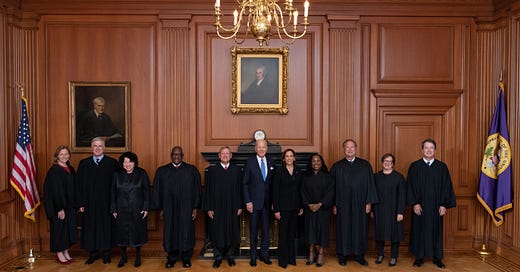Bonus 90: President Biden's SCOTUS Reforms
President Biden's belated push for unattainable (and ineffective) reforms only drives home the opportunities he's missed to change the national conversation about the Supreme Court
Welcome back to the weekly bonus content for “One First.” Although Monday’s regular newsletter will remain free for as long as I’m able to do this, much of the bonus content is behind a paywall as an added incentive for those who are willing and able to support the work that goes into putting this newsletter together every week. I’m grateful to those of you who are already paid subscribers, and hope that those of you who aren’t will consider a paid subscription if and when your circumstances permit:
Although I was originally going to write about the Trump immunity ruling and its broader implications for presidential power going forward (still my plan for next Monday), today’s topic was prompted by Tuesday’s Washington Post scoop—that President Biden is soon to throw his weight behind at least three (according to the Post) Supreme Court-oriented reforms: Term limits; a code of conduct; and a constitutional amendment to undo the Trump immunity ruling. Assuming the Post reporting is accurate (and I’ve seen no denials from the White House), my reaction is basically encapsulated by the following GIF from The West Wing:
To put that into words: (1) these reforms have no chance of being adopted; (2) even if they’re adopted, they’re unlikely to be effective anytime soon; and (3) these reforms are coming way too late—in July of a presidential election year—to do anything other than confirm everyone in their priors. Ultimately, the real effect of this proposal is to drive home just how much President Biden has missed his chances—in December 2021; in the summer of 2022; and even last summer—to meaningfully change our national conversation about the Supreme Court. He may not get another one.
For those who are not paid subscribers, the next free installment of the newsletter will drop on Monday morning. For those who are, please read on.
Let’s start with term limits. Under Article III, Section 1 of the Constitution, the justices “shall hold their Offices during good Behaviour.” The critical point for constitutional purposes is that the nature and duties of the “office” the justices hold are largely defined by Congress. Thus, Congress had the power, from 1789 until 1911, to include circuit-riding as one of the functions of the office. My own view is that Congress can also define the office so that a justice hears merits cases for a fixed period of time, so long as they are given other duties thereafter—so that term limits can be imposed by statute, and not just by constitutional amendment. The problem is that, under an old but consistently followed series of cases, any “non-germane” changes to the nature of an office must be prospective (i.e., only apply to future officeholders), lest Congress use this power as an end-run around the Appointments Clause (by, e.g., giving confirmed officeholders different duties than what they were confirmed to do). So, in my view, statutory term limits would be constitutional only if they went into effect starting with the next justice. That means that, 30-40 years from now, when the last of the current justices leaves the Court, we’d have nine justices with term limits—but not tomorrow. In short, it could work only as a long-term reform, not a short- (or even medium-)term one.
As for a code of conduct, I’ve written about this before, but to me, far more important than the ethics and financial disclosure rules that apply to the justices is how those rules are to be enforced. And although the Post reporting refers to an “enforceable ethics code,” I don’t quite understand how that could be achieved consistent with the Constitution. If anyone other than the justices is given the power to discipline the Court’s members for violations of these rules, we’d no longer have “one Supreme Court,” as Article III, Section 1 says we must; we’d have two. Instead, I’m a firm believer that the way to cut this particular Gordian knot is through the creation of an Article III Inspector General without disciplinary authority over the justices, but with a host of monitoring and reporting obligations that, if structured correctly, ought to create exactly the right kinds of incentives for the justices to comply with the rules already on the books (versus where we are today). An “A3IG” is also long overdue for the lower courts (which continue to get into all kinds of inexplicable trouble), so taking that route versus a new substantive code would have salutary downstream effects, too.
As for a constitutional amendment to override the Trump immunity ruling, why just that one? What about an amendment to overrule Rucho and reaffirm that the federal courts can adjudicate severe partisan gerrymandering? Or an amendment to overrule Citizens United and allow Congress to meaningfully limit the money in our elections? Or an amendment to overrule Dobbs? All of these have the exact same chance of getting two-thirds of the House and Senate to approve them (0.0%), to say nothing of three-fourths of the states.
In other words, unless there is more to what the White House is going to propose than what’s in the Post report, the first two reforms, to be effective in the short-term, would almost certainly be unconstitutional; and the third has less chance of coming to fruition than my childhood dream of being the radio voice of the New York Mets.
More to the point, I find it especially galling that these are the reforms apparently coming out of the White House at this moment—for three different, but related, reasons:
First, it’s not like there aren’t other proposals out there! Law professors; interest groups; and even nerdy newsletter writers have been writing for years about potential reform ideas—many of which are far more nuanced, more likely to be effective, and even more politically viable than the three ideas discussed in the Post report. Indeed, as you may remember, President Biden himself formed a commission to study the prospect of Supreme Court reform. Although that enterprise was never meant to generate concrete reform proposals, it nevertheless compiled quite a lot of information about what is and isn’t wrong with the current Court—a baseline from which more sophisticated conversations about Court reform could have happened, had the White House wanted to facilitate them.
Second, and related, President Biden’s commission filed its report in December 2021. That would have been a good time to start a national conversation about Supreme Court reform. Or June 2022, after the Supreme Court handed down, in quick succession, Bruen (guns), Dobbs (abortion), and West Virginia v. EPA (entrenching the major questions doctrine). Or June 2023, after the Supreme Court all-but-ended race-based affirmative action and President Biden’s student loan debt forgiveness program. Any of those moments would have been understandable provocations for the President of the United States to take the lead in a national conversation about how powerful the Supreme Court has become—and whether, in the long-term, that’s a good thing for our constitutional system. By waiting until July of this year, with the presidential election less than four months away, the White House comes across a bit like Captain Renault in Casablanca—it’s shocked, SHOCKED!, to find that gambling’s going on in here.
Third, and perhaps most importantly, even at this late date, there doesn’t appear to be a theme to these reforms other than “Supreme Court bad.” One could have used the Trump immunity ruling as part of a larger story about institutional accountability—and how the real trouble with the Court right now is how unaccountable it is (and how unaccountable it is making the presidency). That would also provide at least some explanation for focusing on ethics—not to punish the two most visible putative offenders (who, totally coincidentally, happen to be Republican appointees), but to raise the specter of a Court that ought to be checked and balanced the way that it insists on checking and balancing the other branches. There is a story one could tell about how accountability for the Court has gradually eroded, and how the real goal of any President, Democrat or Republican, should be restoring the institution’s real and perceived accountability—for the Court’s sake as much as for the country’s.
Instead, we get these belated, half-hearted, and thematically disconnected proposals that aren’t going to go anywhere. And as frustrating as that missed opportunity is in the abstract, it’s even more problematic if one assumes that discussion and debate of what’s coming from the White House will just consume the oxygen that could otherwise have been devoted to a more productive discussion—both of what’s really wrong with the current Court, and of the more viable (and effective) ways to fix it.
Meanwhile, those inclined to defend the Court at all costs and to push back against any and all reforms (no matter how constitutional, compelling, and necessary they may be), who would likely have had a hard time arguing against, e.g., docket reforms, an inspector general, budgetary accountability, and other more robust congressional oversight, have been given a tree full of low-hanging fruit to pick from instead. Worse, they can claim, not entirely implausibly, that the White House is pushing Court reform not for its own sake, but to score partisan political points with the Democratic base—casting the reforms as little more than an exercise in partisan leverage, rather than in restoring institutional health. The end result will be not only that these reform efforts will fail, but that future efforts to pursue better reforms could become harder to pursue.
Other than that, though, I think it’s a great idea.






While there is merit to some Professor's Vladeck comments, the case for reform is not nearly as dim as he makes it. First, no one thought the reforms outlined by the Biden Supreme Commission could be implemented overnight. This is a political statement and will certainly become a part of the Democratic Platform regardless of who is nominated. Second, Vladseck and Biden both miss the one proposal that can be enacted----by a Democrat Administration. The plan to increase the size of the Court to 13 AND to mandate that there shall be one member from each Circuit could be implemented immediately. Third in that arrangement, the term limit issue is resolved by specifying that at the end of the Supreme Court term the Justice does not retire; rather , the Justice returns to the Circuit from which he or she came and can sit or take senior status as she or he sees fit.
What a disheartening way to start the morning, although I totally agree with your analysis. It is a shame that this is behind the paywall because it would be a good one for public consumption as a lucid, short-hand introduction for folks who may not yet be tuned in to what has been happening with the Supreme Court for some time now.
But I really hated your example of the percentage chance of a constitutional amendment being 0.0%, although I again agree with your prediction since, at 74, I still think the Astros might reach out to me to be the next voice of the Astros.